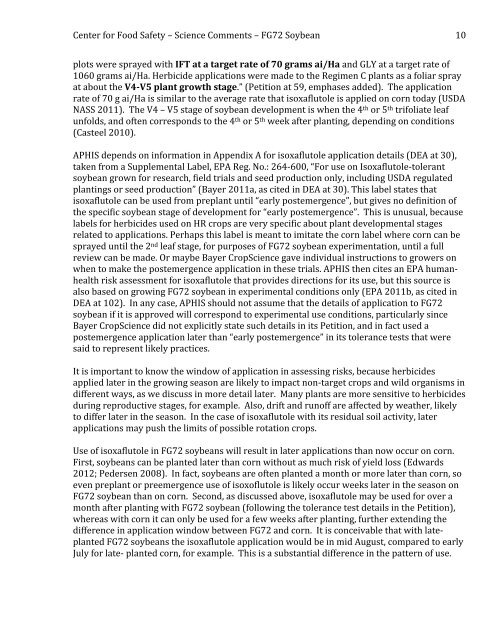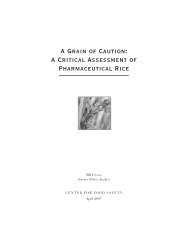a four-fold rise - Center for Food Safety
a four-fold rise - Center for Food Safety
a four-fold rise - Center for Food Safety
Create successful ePaper yourself
Turn your PDF publications into a flip-book with our unique Google optimized e-Paper software.
<strong>Center</strong> <strong>for</strong> <strong>Food</strong> <strong>Safety</strong> – Science Comments – FG72 Soybean <br />
10 <br />
plots were sprayed with IFT at a target rate of 70 grams ai/Ha and GLY at a target rate of <br />
1060 grams ai/Ha. Herbicide applications were made to the Regimen C plants as a foliar spray <br />
at about the V4-V5 plant growth stage.” (Petition at 59, emphases added). The application <br />
rate of 70 g ai/Ha is similar to the average rate that isoxaflutole is applied on corn today (USDA <br />
NASS 2011). The V4 – V5 stage of soybean development is when the 4 th or 5 th trifoliate leaf <br />
un<strong>fold</strong>s, and often corresponds to the 4 th or 5 th week after planting, depending on conditions <br />
(Casteel 2010). <br />
APHIS depends on in<strong>for</strong>mation in Appendix A <strong>for</strong> isoxaflutole application details (DEA at 30), <br />
taken from a Supplemental Label, EPA Reg. No.: 264-‐600, “For use on Isoxaflutole-‐tolerant <br />
soybean grown <strong>for</strong> research, field trials and seed production only, including USDA regulated <br />
plantings or seed production” (Bayer 2011a, as cited in DEA at 30). This label states that <br />
isoxaflutole can be used from preplant until “early postemergence”, but gives no definition of <br />
the specific soybean stage of development <strong>for</strong> “early postemergence”. This is unusual, because <br />
labels <strong>for</strong> herbicides used on HR crops are very specific about plant developmental stages <br />
related to applications. Perhaps this label is meant to imitate the corn label where corn can be <br />
sprayed until the 2 nd leaf stage, <strong>for</strong> purposes of FG72 soybean experimentation, until a full <br />
review can be made. Or maybe Bayer CropScience gave individual instructions to growers on <br />
when to make the postemergence application in these trials. APHIS then cites an EPA human-health<br />
risk assessment <strong>for</strong> isoxaflutole that provides directions <strong>for</strong> its use, but this source is <br />
also based on growing FG72 soybean in experimental conditions only (EPA 2011b, as cited in <br />
DEA at 102). In any case, APHIS should not assume that the details of application to FG72 <br />
soybean if it is approved will correspond to experimental use conditions, particularly since <br />
Bayer CropScience did not explicitly state such details in its Petition, and in fact used a <br />
postemergence application later than “early postemergence” in its tolerance tests that were <br />
said to represent likely practices. <br />
It is important to know the window of application in assessing risks, because herbicides <br />
applied later in the growing season are likely to impact non-‐target crops and wild organisms in <br />
different ways, as we discuss in more detail later. Many plants are more sensitive to herbicides <br />
during reproductive stages, <strong>for</strong> example. Also, drift and runoff are affected by weather, likely <br />
to differ later in the season. In the case of isoxaflutole with its residual soil activity, later <br />
applications may push the limits of possible rotation crops. <br />
Use of isoxaflutole in FG72 soybeans will result in later applications than now occur on corn. <br />
First, soybeans can be planted later than corn without as much risk of yield loss (Edwards <br />
2012; Pedersen 2008). In fact, soybeans are often planted a month or more later than corn, so <br />
even preplant or preemergence use of isoxoflutole is likely occur weeks later in the season on <br />
FG72 soybean than on corn. Second, as discussed above, isoxaflutole may be used <strong>for</strong> over a <br />
month after planting with FG72 soybean (following the tolerance test details in the Petition), <br />
whereas with corn it can only be used <strong>for</strong> a few weeks after planting, further extending the <br />
difference in application window between FG72 and corn. It is conceivable that with late-planted<br />
FG72 soybeans the isoxaflutole application would be in mid August, compared to early <br />
July <strong>for</strong> late-‐ planted corn, <strong>for</strong> example. This is a substantial difference in the pattern of use.







